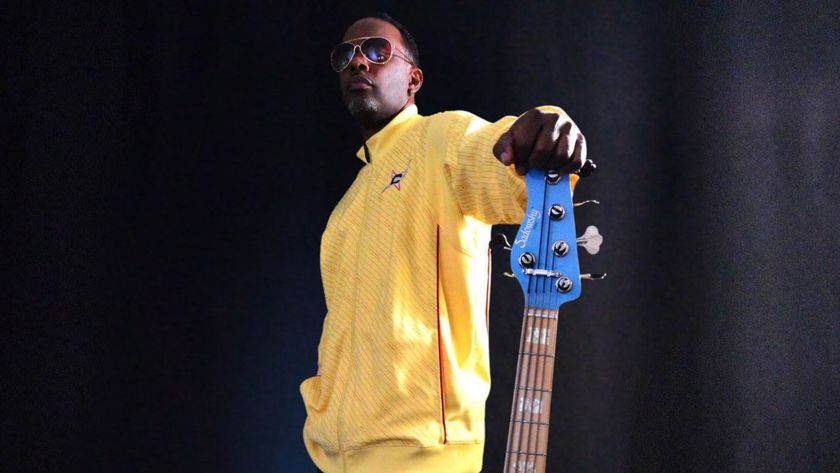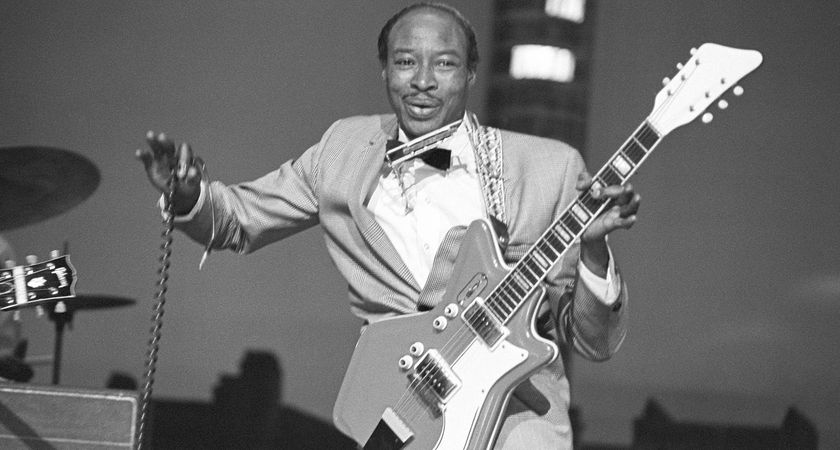Eric Bibb is one of today’s most important acoustic blues guitarists – and his fingerpicking style is an absolute must-learn
In this exclusive video lesson, the wonderful Eric Bibb unpacks his signature style. Grab an acoustic and loosen up, it's time to get started...
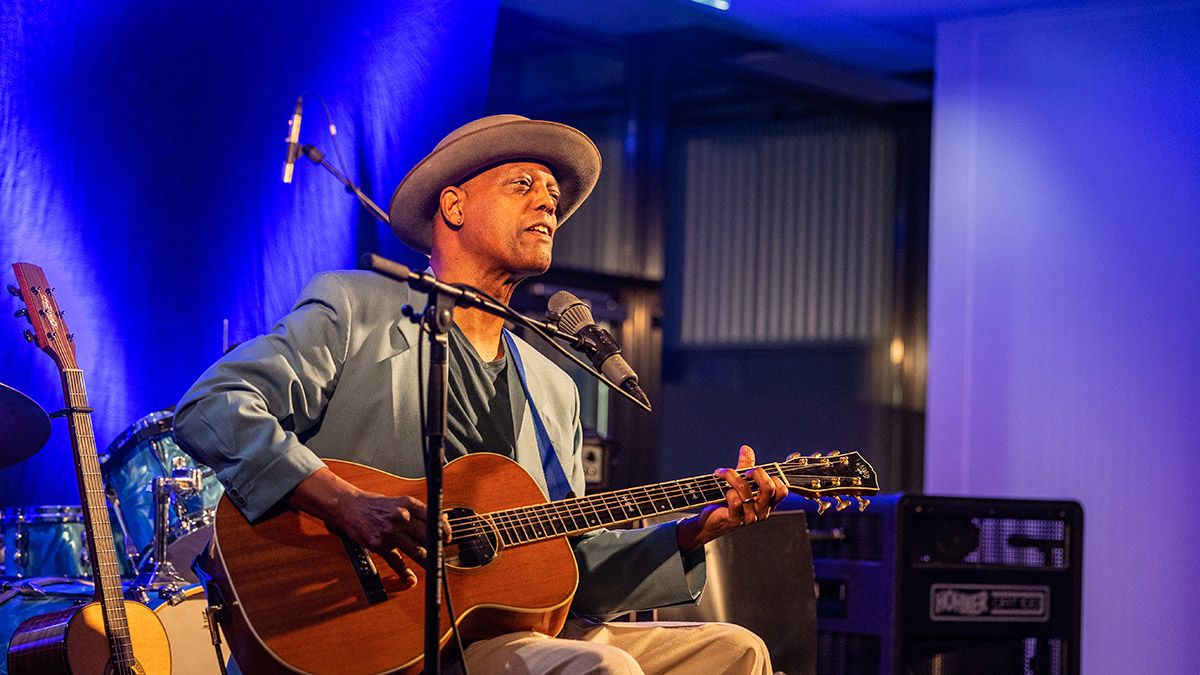
Grammy-nominated singer-songwriter Eric Bibb started his career in the late 1960s and is viewed as one of today’s most important acoustic blues guitar artists. A prolific musician, he has recorded 24 studio albums and four live releases under his own name, and has collaborated on projects with a wide array of artists.
In this exclusive video lesson, Bibb demonstrates six of his favorite acoustic fingerpicking patterns, inspired by artists like Mississippi John Hurt and Bukka White. Bibb performs these parts solo, as he would in a live or recording situation, but pay particular attention to his innate groove and rock solid timing; that foot is tapping the beat all the way through and he's able to play right on it, or swing around it as he sees fit.
There are some idiosyncrasies to Bibb’s playing – you may find his A chord shape a bit of a challenge, and you’ll have to deal with his thumb-over-the-neck fretting technique. Persevere with both and you’ll uncover a fascinating style that seamlessly combines moving basslines and chord patterns. For the basslines Bibb uses his thumb alternating on the bottom three strings, with hammer-on embellishments of chords on the top.
Bibb's sense of time and groove is fantastic. He performs these parts in both 4/4 time and 12/8, and applies a swing feel to both. Getting this feel in place can be a challenge and I’d recommend ensuring that you have the fretting and picking-hand parts down first. When these elements have fallen into place try approximating his unhurried groove, moderating how much swing you imply, from less to more.
Swing is a very personal thing; some feel it naturally while others give the impression they are holding on for dear life! Bibb is a master of this feel, so just make sure you're tapping your own foot evenly throughout, or, even better, get a metronome and record yourself playing these parts so you can get a sense of where in the beat your parts are landing.
Given the detail in some of these ideas I’d suggest getting the fretting hand comfortable with the shapes and what’s going on within them, before introducing the picking hand.
Finally, Bibb's thumb-over-the-top technique is a real challenge so don’t be disheartened if it doesn’t fall into place right away. If you own a couple of acoustics you might find it a good idea to try both, and see which one is easier to play this technique on.
Good luck, and happy picking!
Get the tone
Amp Settings: Gain 3, Bass 7, Middle 6, Treble 7, Reverb 2
In the video Bibb is playing a Waterloo guitar, which gives a dry, vintage sound that’s perfect for acoustic blues. He also has a signature guitar made by Fylde in the UK.
A small-bodied, crisp-sounding guitar is perfect for this style, and due to its size may also help with the intricacies of Bibb’s technique. Use the above settings as a basis for an amped sound.
Example 1

First, don’t forget to tune the sixth string down a tone from E to D. Here’s an alternating bassline pattern played against triads on the top three strings. Use the picking hand thumb to alternate the bassline on the sixth and fourth strings and the first, second, and third fingers to pick the triads on the top strings.
Example 2

This one is typical acoustic country blues. The 12/8 time signature and triplet feel leads to a challenging rhythm as the picking-hand thumb plays bass notes on the beat, while the lick on the top two strings is played in triplets within the beat. Work on the first beat to feel the contrast between the bassnote and the lick.
Example 3
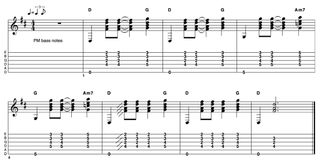
Similar to the first example, here Bibb again uses triads against the low bass note to outline a simple I- IV chord progression (D-G) with a little added color. However, unlike Example 1, in this example Bibb uses his picking hand first finger to brush down and up the top four strings. It’s a satisfying technique to get under the fingers.
Example 4
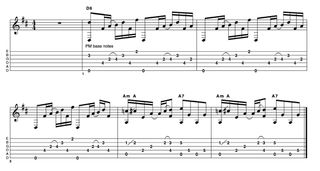
Major 6 chords are at the heart of the pastoral country blues sound and Bibb often uses them in his playing. This example looks rather intricate on the page but, as you’ll see from the video, he is working out of chord shapes and then hammering-on or sliding into notes to create the color. Make sure the chords and these embellishments are properly under your fingers before performing the arpeggiated patterns.
Example 5
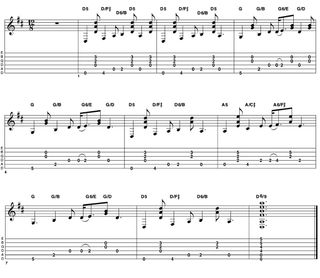
Walking basslines are another feature of country blues and this example is insipired by piano players like Fats Domino from New Orleans. The challenge in this example comes when Bibb wraps his thumb over the neck to play notes on the 2nd fret of the fifth string. If this is too awkward, try using the first finger to form a barre across the 2nd fret so you can hold down both the bassnotes and 2nd-fret notes within the chords.
Example 6

Here’s another example of how Bibb adds the color of 9ths and 6ths to his chords. While these examples again look intricate on the page, if you watch the video you’ll see he is embellishing familiar chord shapes, so begin with the shapes, add the embellishments, then introduce the picking-hand arpeggios and rhythms.
Get The Pick Newsletter
All the latest guitar news, interviews, lessons, reviews, deals and more, direct to your inbox!

Want to play Master of Puppets the right way? Here's how to get faster at downpicking so you can chug like James Hetfield
![Joe Bonamassa [left] wears a deep blue suit and polka-dotted shirt and plays his green refin Strat; the late Irish blues legend Rory Gallagher [right] screams and inflicts some punishment on his heavily worn number one Stratocaster.](https://cdn.mos.cms.futurecdn.net/cw28h7UBcTVfTLs7p7eiLe-840-80.jpg)
“The intensity of Rory’s guitar playing – the emotion, the sound and his incredible attack – was mindblowing for me”: Joe Bonamassa pays tribute to the late, great Irish blues-rock icon Rory Gallagher
